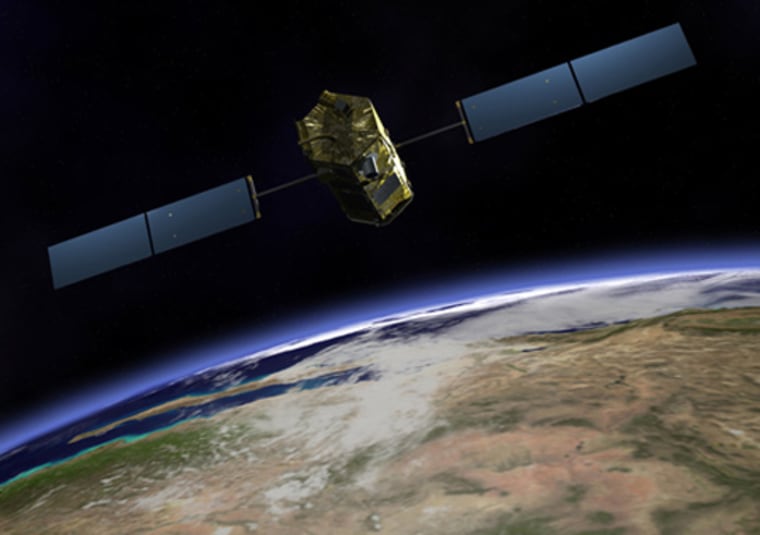The occasionally acrimonious debate about the planet's climate has been missing a key component: accurate measurements of how much carbon dioxide is in the air and how it is being recycled by Earth.
That is the heart of a new NASA mission called the Orbital Carbon Observatory, which is set to launch early next year.
"We will uncover all kinds of patterns and cycles in carbon dioxide that people never thought existed. It'll be just like when the first ozone measurements were made," said project scientist Chip Miller, with the Jet Propulsion Laboratory in Pasadena, Calif.
"We get at the question of the sources of carbon dioxide and see how much is pulled out (of the atmosphere) by land and how much by seas," he said.
Many scientists consider carbon dioxide to be the telltale gas of global warming. Once it is released into the air, there is little chemistry to remove it. Its presence traps reflected sunlight. Plants, soils and the oceans of Earth reabsorb the gas, but that takes a while. Miller says that the average lifetime for carbon dioxide is about 300 years. About 20 percent of atmospheric carbon dioxide, however, lasts for 10,000 years or longer.
Most carbon dioxide — about 97 percent — comes from natural sources. That's roughly 300 billion metric tons per year of CO2 gas from breathing animals, decaying plants, forest fires, volcanic eruptions and other naturally occurring phenomena.
Human activities, like driving cars, burning coal, farming, industrial production and other practices, account for 3 percent, or about 8 billion metric tons of carbon dioxide production per year.
That may not sound like much, but it is widely believed that it is the human endeavors which are responsible for resetting Earth's temperature.
"It's such a small portion, but it does seem to be tilting the balance," Miller said.
What is missing, however, are precise measurements of how much carbon is being put into the atmosphere and how much is coming out. It's a measurement that is extremely difficult to make. Data so far comes from about 100 ground sites spread throughout the world and from extrapolations from reports such as oil, coal and natural gas sales.
The presumption is that these fossil fuels will be burned, emitting carbon dioxide in the process.
Scientists believe the economic data is accurate to about 10 percent. Not all countries will provide the information, however.
"When we add together what we know about the system, we can't account for about 2 billion metric tons from the atmosphere," Miller told Discovery News. "Balancing the carbon budget is one of the key things that scientists are trying to do now."
"This is an absolutely critical question," added David Crisp, the lead scientist for the Orbital Carbon Observatory, or OCO. "Where is the other half of the carbon dioxide that we emit into the air going over time and will the Earth continue to absorb (it) as we go into the future?"
Measuring carbon dioxide is not an easy task. OCO will attempt the work by using three high-resolution spectrometers to study sunlight reflected off Earth at the precise wavelengths that reveal the presence of carbon dioxide and molecular oxygen.
The observatory is sensitive enough to identify columns of carbon within an area as small as about three square kilometers. The goal is to find the areas where the concentration of carbon dioxide is less than 1 part per million different than overall background levels of carbon dioxide, which are about 383 parts per million.
"Our goal is to identify, on regional scales, where this atmospheric CO2 is actually going," said deputy project manager Ralph Basilio.
"These measurements have never been made from space before with this accuracy," Miller added. "We are a pathfinder, we are the first to try to demonstrate how this could be done."
OCO will fly over the planet in 16-day cycles from a 483-mile-high orbit in sync with the sun so that it is always the same time of day on the ground below — 1:26 p.m. On cloudy days, the measurements will not be able to reach all the way to the ground, but over time, scientists expect to collect enough data to identify particular sources of carbon dioxide and absorption spots, known as sinks.
Information will be stored on the spacecraft and radioed once a day to a collecting station in Alaska, then relayed to NASA's Goddard Space Flight Center in Greenbelt, Md., for processing. Analysis will take place at JPL and other science centers involved in the project.
Once in position, OCO will operate in formation with five other Earth-monitoring spacecraft that comprise what is called the "A-Train," or afternoon constellation, which cross the equator shortly after noon every day.
"We'll be able to create new and even more interesting data products," Miller said.
NASA is paying about $270 million for the observatory, its launch on an Orbital Sciences' Taurus booster and two years of operation. Launch is targeted for Jan. 30 from Vandenberg Air Force Base in California.
